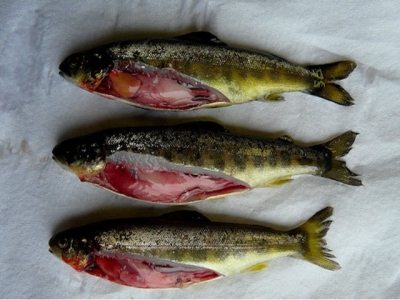Fish disease guide - Infectious Pancreatic Necrosis (IPN)

What Is It?
Infectious pancreatic necrosis (IPN) is an infectious viral disease that affects numerous species of fish in many different parts of the world. The causitive agent, infectious pancreatic necrosis virus (IPNV), has also been isolated from shellfish. Clinical disease is particularly important in farmed Atlantic salmon (Salmo salar L.), rainbow trout (Oncorhynchus mykiss).
Where and When Might it Occur?
In farms, mortalities occur mainly in the fry (or juvenile) stages, but in recent years Atlantic salmon post-smolts have suffered considerable mortalities from IPN, especially in Norway and Scotland. All age groups of fish, in both fresh and sea water environments can be infected asymptomatically and may shed virus.
In Scotland, the prevalence of IPNV infection is very high in famed Atlantic salmon in sea water. In freshwater salmon farms, the prevalence of infection and incidence of disease is considerably lower, but has increased in recent years.
Diagnosis
Clinical disease may be characterised by a swollen abdomen or eyes, darkening of the skin, spiral swimming and faecal casts trailing from the vent.
Internally there may be pancreatic necrosis, a catarrhal exudate in the intestine and haemorrhages in the visceral organs.
IPNV is an Aquabirnavirus the presence of which can be confirmed by isolation in tissue culture and identification by Enzyme Linked Immuno Sorbant Assay (ELISA), antibody neutralisation or Polymerase Chain Reaction (PCR).
Control
IPNV may be vertically transmitted from parent to progeny. Consequently it is recommended that any broodstock originating from infected farms should be tested for the virus at time of stripping, and eggs from infected parents should be destroyed.
IPNV is a very robust virus and can be transmitted in fresh and salt water, on equipment, and can survive in silage waste and in the gut of birds and mammals, allowing it to be transmitted in faeces. Movement of equipment from infected sites should be avoided, and mortalities and other wastes should be regarded as highly infectious.
Treatment
A provisional marketing authorisation has been granted for a vaccine against IPN
Có thể bạn quan tâm
 Fish disease guide - Enteric Septicaemia of Catfish
Fish disease guide - Enteric Septicaemia of Catfish Enteric septicaemia of catfish, or Hole-in-the-Head disease, is caused by the bacterium Edwardsiella ictaluri, which belongs to the family Enterobacteriaceae.
 Fish disease guide - Gyrodactylus Salaris
Fish disease guide - Gyrodactylus Salaris Only Atlantic salmon are severely affected by this parasite, although G. salaris has been reported from Atlantic salmon (Salmo salar)
 Fish disease guide - Furunculosis
Fish disease guide - Furunculosis Furunculosis is highly contagious disease that affects fish of all ages. Aeromonas salmonicida, the infection causes high mortality in salmonids